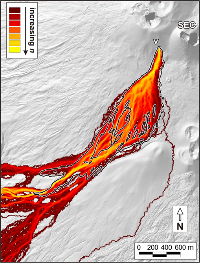Simulating the area covered by lava flows using the DOWNFLOW code
Tarquini S., M. Favalli (2015).
Geological Society, London, Special Publications, 426, http://doi.org/10.1144/SP426.15
Abstract
DOWNFLOW is a probabilistic code for the simulation of the area covered by lava flows. This code has been used extensively for several basaltic volcanoes in the last decade, and a review of some applications is presented. DOWNFLOW is based on the simple principle that a lava flow tends to follow the steepest descent path downhill from the vent. DOWNFLOW computes the area possibly inundated by lava flows by deriving a number, N, of steepest descent paths, each path being calculated over a randomly perturbed topography. The perturbation is applied at each point of the topography, and ranges within the interval ±Δh. N and Δh are the two basic parameters of the code. The expected flow length is constrained by statistical weighting based on the past activity of the volcano. The strength of the code is that: (i) only limited volcanological knowledge is necessary to apply the code at a given volcano; (ii) there are only two (easily tunable) input parameters; and (iii) computational requirements are very low. However, DOWNFLOW does not provide the progression of the lava emplacement over time. The use of DOWNFLOW is ideal when a large number of simulations are necessary: for example, to compile maps for hazard and risk-assessment purposes.
http://sp.lyellcollection.org/content/early/2015/07/17/SP426.15.abstract


